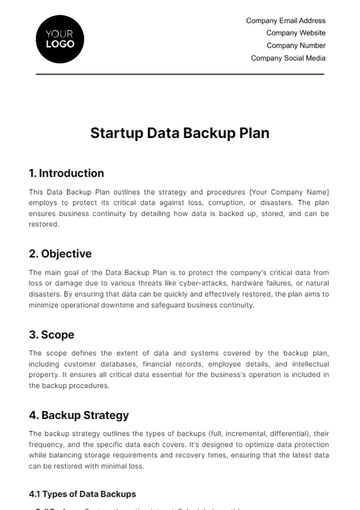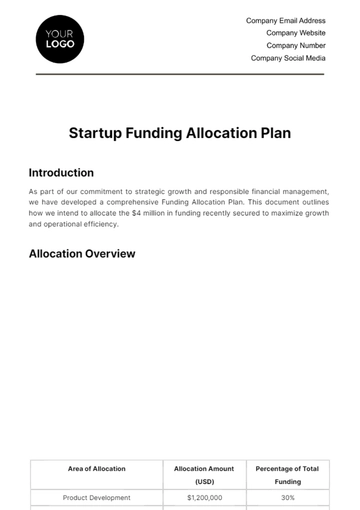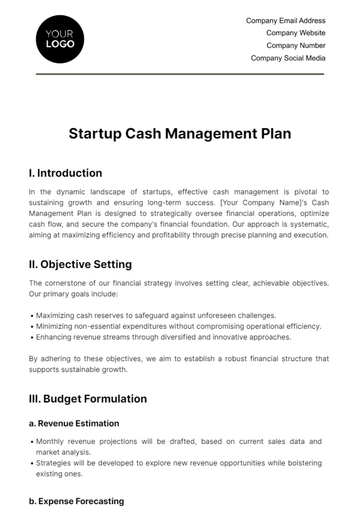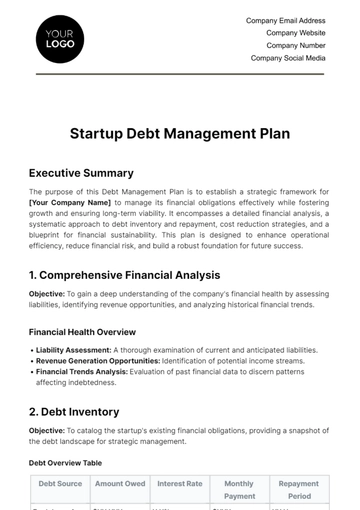Free Startup Data Backup Plan
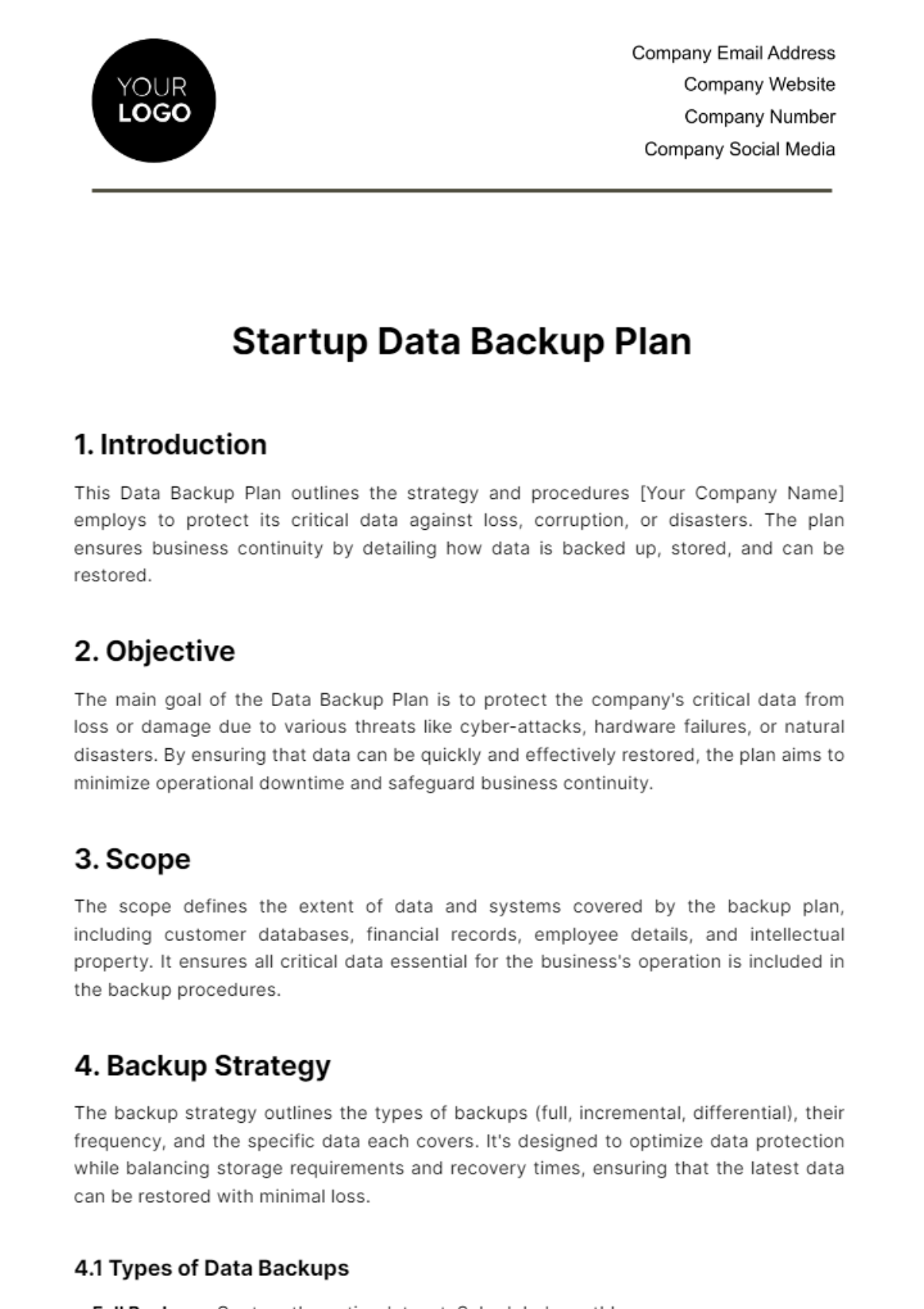
1. Introduction
This Data Backup Plan outlines the strategy and procedures [Your Company Name] employs to protect its critical data against loss, corruption, or disasters. The plan ensures business continuity by detailing how data is backed up, stored, and can be restored.
2. Objective
The main goal of the Data Backup Plan is to protect the company's critical data from loss or damage due to various threats like cyber-attacks, hardware failures, or natural disasters. By ensuring that data can be quickly and effectively restored, the plan aims to minimize operational downtime and safeguard business continuity.
3. Scope
The scope defines the extent of data and systems covered by the backup plan, including customer databases, financial records, employee details, and intellectual property. It ensures all critical data essential for the business's operation is included in the backup procedures.
4. Backup Strategy
The backup strategy outlines the types of backups (full, incremental, differential), their frequency, and the specific data each covers. It's designed to optimize data protection while balancing storage requirements and recovery times, ensuring that the latest data can be restored with minimal loss.
4.1 Types of Data Backups
Full Backups: Capture the entire dataset. Scheduled monthly.
Incremental Backups: Record changes since the last backup. Conducted daily.
Differential Backups: Record changes since the last full backup. Conducted weekly.
4.2 Backup Schedule
Backup Type | Frequency | Time | Data Covered |
|---|---|---|---|
Full | Monthly | 1st Sunday | All data |
Incremental | Daily | 2 AM | Changes since last backup |
Differential | Weekly | Sunday 2 AM | Changes since last full backup |
4.3 Storage Locations
Primary Location: On-site servers for immediate access.
Secondary Location: Off-site cloud storage for disaster recovery. [Your Company Name] utilizes [Cloud Service Provider] with encryption for data security.
5. Roles and Responsibilities
This section assigns specific duties to team members:
The IT Manager oversees the overall backup strategy.
The Data Protection Officer ensures compliance with data privacy laws.
System Administrators are responsible for executing the backup and restoration processes.
6. Backup Procedure
The backup procedure involves three main steps: pre-backup checks, executing the backups according to schedule, and post-backup verification.
Pre-Backup: Verify system integrity and check for updates or issues.
Executing Backups: Automated scripts run as per the schedule. System administrators monitor for errors or failures.
Post-Backup: Verify backup completeness and integrity. Update backup logs.
This ensures that backups are not only taken regularly but are also reliable and complete.
7. Security Measures
Security measures include encryption of data in transit and at rest, and strict access controls. These protocols ensure that backup data is protected against unauthorized access and breaches, maintaining the confidentiality and integrity of sensitive information.
8. Data Restoration
Data restoration is a critical component of the backup plan, ensuring that the business can quickly recover from data loss and resume normal operations with minimal downtime. This process involves several key elements:
Key Elements | Description |
|---|---|
Restoration Testing | Regularly scheduled tests are conducted to validate the integrity and effectiveness of the backup data. These tests help identify any issues with the backup files and the restoration process before an actual data recovery situation arises. |
Restoration Procedure | In the event of data loss, a predefined protocol is followed to recover the lost data. This involves identifying the most recent and relevant backup version, ensuring it matches the data needs and integrity requirements for restoration. |
Prioritization | Critical data that is essential for business operations is prioritized for restoration to ensure that the most important services are resumed as quickly as possible. |
Documentation | Every restoration effort is thoroughly documented, including the scope of data loss, the restoration process, any issues encountered, and the outcome. This documentation is crucial for reviewing the effectiveness of the backup and restoration plan and for making necessary adjustments. |
9. Security Measures
The Security Measures section outlines the protocols in place to protect backup data from unauthorized access, corruption, or theft. Key aspects include:
Key Aspects | Description |
|---|---|
Encryption | All backup data is encrypted, both in transit to the backup location and at rest once it is stored. This ensures that even if data is intercepted or accessed by unauthorized individuals, it remains unreadable and secure. |
Access Control | Strict access control measures are implemented to ensure that only authorized personnel have the ability to perform backups and access backup data. This is typically managed through role-based access controls (RBAC), which assign specific permissions based on the individual's role within the organization. |
Physical Security | For backups stored on-site or in physical off-site locations, measures such as secure, locked facilities, surveillance cameras, and access logs are used to protect against unauthorized physical access. |
Regular Security Audits | Conducting regular audits of the backup and restoration processes helps identify potential vulnerabilities and ensures that security measures are up to date. This may include reviewing access logs, testing encryption protocols, and ensuring that all personnel are following security best practices. |
Compliance with Regulations | Ensuring that the backup and data restoration processes comply with relevant data protection regulations (such as GDPR, HIPAA, etc.) is crucial. This includes aspects like data minimization, the right to erasure, and data portability. |
10. Review and Update
The plan includes a provision for regular reviews and updates to adapt to new business needs, technological advancements, or changes in data regulations. This ensures the backup strategy remains effective and compliant over time.
Prepared By: [Your Name], [Your Job Title]
Updated: [Month, Day, Year]
- 100% Customizable, free editor
- Access 1 Million+ Templates, photo’s & graphics
- Download or share as a template
- Click and replace photos, graphics, text, backgrounds
- Resize, crop, AI write & more
- Access advanced editor
Secure your startup's future with the Data Backup Plan Template from Template.net. Tailored for emerging businesses, this template is fully customizable and editable through an Ai Editor Tool, ensuring your data protection strategy is robust and flexible. Implement a comprehensive backup plan that grows with your startup, safeguarding your most valuable asset—your data.
You may also like
- Finance Plan
- Construction Plan
- Sales Plan
- Development Plan
- Career Plan
- Budget Plan
- HR Plan
- Education Plan
- Transition Plan
- Work Plan
- Training Plan
- Communication Plan
- Operation Plan
- Health And Safety Plan
- Strategy Plan
- Professional Development Plan
- Advertising Plan
- Risk Management Plan
- Restaurant Plan
- School Plan
- Nursing Home Patient Care Plan
- Nursing Care Plan
- Plan Event
- Startup Plan
- Social Media Plan
- Staffing Plan
- Annual Plan
- Content Plan
- Payment Plan
- Implementation Plan
- Hotel Plan
- Workout Plan
- Accounting Plan
- Campaign Plan
- Essay Plan
- 30 60 90 Day Plan
- Research Plan
- Recruitment Plan
- 90 Day Plan
- Quarterly Plan
- Emergency Plan
- 5 Year Plan
- Gym Plan
- Personal Plan
- IT and Software Plan
- Treatment Plan
- Real Estate Plan
- Law Firm Plan
- Healthcare Plan
- Improvement Plan
- Media Plan
- 5 Year Business Plan
- Learning Plan
- Marketing Campaign Plan
- Travel Agency Plan
- Cleaning Services Plan
- Interior Design Plan
- Performance Plan
- PR Plan
- Birth Plan
- Life Plan
- SEO Plan
- Disaster Recovery Plan
- Continuity Plan
- Launch Plan
- Legal Plan
- Behavior Plan
- Performance Improvement Plan
- Salon Plan
- Security Plan
- Security Management Plan
- Employee Development Plan
- Quality Plan
- Service Improvement Plan
- Growth Plan
- Incident Response Plan
- Basketball Plan
- Emergency Action Plan
- Product Launch Plan
- Spa Plan
- Employee Training Plan
- Data Analysis Plan
- Employee Action Plan
- Territory Plan
- Audit Plan
- Classroom Plan
- Activity Plan
- Parenting Plan
- Care Plan
- Project Execution Plan
- Exercise Plan
- Internship Plan
- Software Development Plan
- Continuous Improvement Plan
- Leave Plan
- 90 Day Sales Plan
- Advertising Agency Plan
- Employee Transition Plan
- Smart Action Plan
- Workplace Safety Plan
- Behavior Change Plan
- Contingency Plan
- Continuity of Operations Plan
- Health Plan
- Quality Control Plan
- Self Plan
- Sports Development Plan
- Change Management Plan
- Ecommerce Plan
- Personal Financial Plan
- Process Improvement Plan
- 30-60-90 Day Sales Plan
- Crisis Management Plan
- Engagement Plan
- Execution Plan
- Pandemic Plan
- Quality Assurance Plan
- Service Continuity Plan
- Agile Project Plan
- Fundraising Plan
- Job Transition Plan
- Asset Maintenance Plan
- Maintenance Plan
- Software Test Plan
- Staff Training and Development Plan
- 3 Year Plan
- Brand Activation Plan
- Release Plan
- Resource Plan
- Risk Mitigation Plan
- Teacher Plan
- 30 60 90 Day Plan for New Manager
- Food Safety Plan
- Food Truck Plan
- Hiring Plan
- Quality Management Plan
- Wellness Plan
- Behavior Intervention Plan
- Bonus Plan
- Investment Plan
- Maternity Leave Plan
- Pandemic Response Plan
- Succession Planning
- Coaching Plan
- Configuration Management Plan
- Remote Work Plan
- Self Care Plan
- Teaching Plan
- 100-Day Plan
- HACCP Plan
- Student Plan
- Sustainability Plan
- 30 60 90 Day Plan for Interview
- Access Plan
- Site Specific Safety Plan












